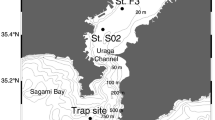Abstract
Successive sediment trap deployments were made over a two-year period at a site 360 km west of Cape Mendocino (39.5°N, 128°W). In the final deployment, the shallowest trap was equipped with a sample changer which provided three consecutive samples during the spring and summer of 1981 in order to study possible seasonal variations due to the influence of coastal upwelling. Biogenic flux data point to increasing productivity at the site from mid-March through the end of August, 1981. The ratio of opal flux to carbonate flux increases from spring to a mid-summer maximum. Radiolarians dominate the spring opal flux, whereas diatoms are the major contributors to opal flux in the mid and late summer. Changes in the distributions of three silicoflagellate species suggest colder temperatures occur in mid to late summer. Upwelling at the latitude of our mooring is greatest in midsummer. Although upwelling occurs near the coast, colder water, possibly with higher nutrient levels, can be advected rapidly offshore in the form of surface plumes. Satellite images from April through July, 1981, reveal at least three plumes crossing our area during the period June 21-July 29. These cold water plumes extended from Cape Mendocino to the mooring location. The occurrence of such plume events can explain the flux patterns and changes in other indicators recorded during the spring-summer period by our multiple sampling sediment trap.
Access this chapter
Tax calculation will be finalised at checkout
Purchases are for personal use only
Preview
Unable to display preview. Download preview PDF.
Similar content being viewed by others
References
Breaker, L.C. and Gilliland, R.P., 1981, A satellite sequence on up-welling along the California coast, in: “Coastal Upwelling,” F.A. Richards, ed., American Geophysical Union, Washington, 87–94.
Dymond, J., Fischer, K., Clauson, M., Cobler, R., Gardner, W., Richardson, M.J., Berger, W., Soutar, A. and Dunbar, R., 1981, A sediment trap intercomparison study in the Santa Barbara Basin, Earth and Planetary Science Letters, 53: 409–418.
Fukui, S., 1976, Laboratory techniques used for atomic absorption spectrophotometric analysis of geologic samples, Oregon State University, School of Oceanography, Ref. 76–10.
Griggs, G.B. and Hein, J.R., 1980, Sources, dispersal, and clay mineral composition of fine-grained sediment off central and northern California, Journal of Geology, 88: 541–566.
Heath, G.R., 1982, Oceanographic studies through December 1981 at Pacific site W-N, Appendix G in: “Oceanographic Data for Assessing the Sea Disposal of Large Irradiated Structures,” D. Talbert, ed., Report SAND 82–1005, Sandia National Laboratories, Albuquerque, 2–10.
Honjo, S., Manganini, S.J. and Cole, J.J., 1982, Sedimentation of biogenic matter in the deep ocean, Deep-Sea Research, 29: 609–625.
Imbrie, J. and Kipp, N.G., 1971, A new micropaleontological method for quantitative paleoclimatology: Application to a late Pleistocene Caribbean core, in: “Late Cenozoic Glacial Ages,” K.K. Turekian, ed., Yale University Press, New Haven, 71–181.
Karlin, R., Heath, G.R. and Levi, S., 1982, Summary of historical oceanographic and climatological data for west coast potential disposal sites W-N and W-S, Appendix C in: “Oceanographic Data for Assessing the Sea Disposal of Large Irradiated Structures,” D. Talbert, ed., Report SAND 82–1005, Sandia National Laboratories, Albuquerque.
Malone, T.C., 1971, The relative importance of nannoplankton and net-plankton as primary producers in the California Current system, Fishery Bulletin, 69 (4): 799–820.
Poelchau, H.S., 1974, “Holocene Silicoflagellates of the North Pacific: Their Distribution and Use for Paleotemperature Determination,” Ph.D. Dissertation, University of California, San Diego, 165 pp.
Powell, H.S. and Fischer, K., 1982, Comparison study of bactericides for sediment traps, American Geophysical Union ( Abstracts, Fall Meeting 1982 ), 052B - 0.
Reid, J.L., Jr., Roden, G.I. and Wyllie, J.G., 1958, Studies of the California Current system, California Cooperative Fisheries Investigations Reports, 6: 27–56.
Russell-Hunter, W.D., 1970, “Aquatic Productivity: An Introduction to Some Basic Aspects of Biological Oceanography and Limnology,” The Macmillan Company, Collier-Macmillan Limited, London, 306 pp.
Soutar, A., Kling, S.A., Crill, P.A. and Duffrin, E., 1977, Monitoring the marine environment through sedimentation, Nature, 266: 136–139.
Spencer, D.W., Honjo, S. and Brewer, P.G., 1982, Panama Basin sediment trap intercomparison experiment: August-November, 1979, American Geophysical Union/American Society of Limnology and Oceanography Meeting Abstracts, EOS, 63 (3): 45.
Traganza, E.D., Conrad, J.C. and Breaker, L.C., 1981, Satellite observations of a cyclonic upwelling system and giant plume in the California Current, in: “Coastal Upwelling,” F.A. Richards, ed., American Geophysical Union, Washington, 228–241.
van Bennekom, A.J. and van der Gaast, S.J., 1976, Possible clay structures in frustules of living diatoms, Geochimica et Cosmo-chimica Acta, 40: 1149–1152.
Weliky, K., 1982, “Clay-organic Associations in Marine Sediments: Carbon, Nitrogen and Amino Acids in the Fine-grained Fractions,” M.S. Thesis, Oregon State University, Corvallis, 166 pp.
Author information
Authors and Affiliations
Editor information
Editors and Affiliations
Rights and permissions
Copyright information
© 1983 Plenum Press, New York
About this chapter
Cite this chapter
Fischer, K., Dymond, J., Moser, C., Murray, D., Matherne, A. (1983). Seasonal Variation in Particulate Flux in an Offshore Area Adjacent to Coastal Upwelling. In: Suess, E., Thiede, J. (eds) Coastal Upwelling Its Sediment Record. NATO Conference Series, vol 10B. Springer, Boston, MA. https://doi.org/10.1007/978-1-4615-6651-9_11
Download citation
DOI: https://doi.org/10.1007/978-1-4615-6651-9_11
Publisher Name: Springer, Boston, MA
Print ISBN: 978-1-4615-6653-3
Online ISBN: 978-1-4615-6651-9
eBook Packages: Springer Book Archive




